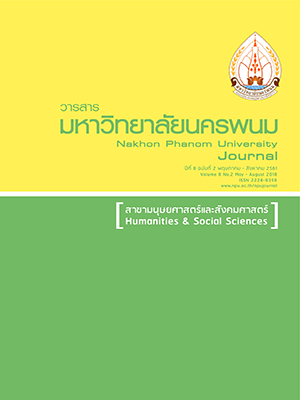บ้านภู : อัตลักษณ์ทางชาติพันธุ์ผู้ไทกับการบริหารการพัฒนาในบริบทการท่องเที่ยวเชิงวัฒนธรรมที่ยั่งยืน
Main Article Content
Abstract
The objectives of this study were to investigate: 1) the general condition of the Phutai community that includes geography, economy, politics, society, culture and the Phutai ethnic identity in Ban Phu village, 2) the management of cultural tourism by the community of Ban Phu millage, and 3) the model of Phutai ethnic identity and development administration for leading to be a village of sustainable cultural tourism. Participatory and non-participatory observation, in-depth interview with the key performants, and workshop were employed. The group of key informants consisted of 10 knowledgeable people, 40 local entrepreneurs, and 25 general information providers. The data were checked for accuracy by means of triangulation. Data were analyzed according to the objectives indicated, and the findings of the study were presented in the form of descriptive analysis and synthesis.
The findings were as follows: 1) Ban Phu village was in Ban Pao sub-district, Nong Sung district, Mukdahan province. It is located on the highland hill named ‘Hin Lek Fai’. Most people in this village constituted a Phutai ethnic group. Ban Phu villagers were obviously conscious of being in a touching of Phutai ethnic such as the tribal way of life, Phutai language, blue/red costumes, food, history, six learning bases according to the Philosophy of Sufficiency Economy, Phutai cultural yard, Phutai dancing, and manufacture of products and services of the community. 2) The management of cultural tourism. The people of Ban Phu village have adapted their ethnic identity to be a selling point for cultural tourism through “commoditization of culture” or “culture for tourism” and have established the organization and process of ethnic identity. 3) The model of Phutai ethnic identity and development administration in the context of sustainable cultural tourism consists of establishment of an organization, making a strategy of ethnic consciousness, giving a definition of Phutai, creation and selection of the village symbol, presentation of Phutai ethnic identity in the context of cultural tourism, and presentation of Phutai ethnic identity under the interaction with the tourists.
Article Details
References
บุญเลิศ จิตตั้งวัฒนา และเพ็ญศิริ ศรีคำภา. (2557). การพัฒนาการท่องเที่ยวแบบยั่งยืน. กรุงเทพฯ : เพรส แอนด์ ดีไซน์.
ประคอง จุลสอน. (2557). รูปแบบกระบวนการเรียนรู้อัตลักษณ์ชุมชน ผ่านเครือข่ายญ้อ ตำบลคลองขาม อำเภอยางตลาด จังหวัดกาฬสินธุ์. วิทยานิพนธ์ปริญญาดุษฎีบัณฑิต. มหาสารคาม : มหาวิทยาลัยราชภัฏมหาสารคาม.
ปานแพร เชาวน์ประยูร. (2555). ปาย : การสร้างอัตลักษณ์และการให้ความหมายเชิงสัญญะทางวัฒนธรรมเพื่อการท่องเที่ยว. วิทยานิพนธ์ปริญญาดุษฎีบัณฑิต. เชียงใหม่ : มหาวิทยาลัยแม่โจ้.
ปารณทัตต์ แสนวิเศษ. (2555). การมีส่วนร่วมของชุมชนในการจัดการศึกษาขั้นพื้นฐานของโรงเรียนประถมศึกษา: การสร้างทฤษฎีฐานราก. วิทยานิพนธ์ปริญญาดุษฎีบัณฑิต สาขาวิชาการบริหารและพัฒนาการศึกษา สกลนคร : มหาวิทยาลัยราชภัฏสกลนคร.
เยาวดี ด้วงกูล. (2555). การท่องเที่ยวเชิงวัฒนธรรม: การพัฒนาศักยภาพการท่องเที่ยวโดยการมีส่วนร่วมของชุมชน ภาคใต้ตอนบน. วิทยานิพนธ์ปริญญาดุษฎีบัณฑิต. มหาสารคาม : มหาวิทยาลัยราชภัฏมหาสารคาม.
วิรัช วิรัชนิภาวรรณ. (2555). การบริหารจัดการและการบริหารยุทธศาสตร์ของหน่วยงานของรัฐ. กรุงเทพฯ : ธนธัชการพิมพ์.
สุดแดน วิสุทธิลักษณ์ และคณะ. (2555). ต้นแบบการท่องเที่ยวเชิงสร้างสรรค์. คณะสังคมวิทยาและมานุษยวิทยา กรุงเทพฯ : มหาวิทยาลัยธรรมศาสตร์.
อรวรรณ บุญพัฒน์. (2557). การพัฒนารูปแบบการท่องเที่ยวเชิงวัฒนธรรมของจังหวัดเชียงราย. วิทยานิพนธ์ปริญญาดุษฎีบัณฑิต. ขอนแก่น : มหาวิทยาลัยขอนแก่น.


